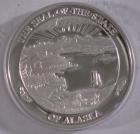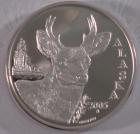2005 Alaska Medallion - The Sitka Deer


Total one ounce proof mintage: 5,100
Current List Price $225.00
Our Price $195.00
Information put out by the Alaska Department of Fish and Game describes the Sitka black-tailed deer (Odocoileus hemionus sitkensis) as "native to the wet coastal rain forests of Southeast Alaska and north-coastal British Columbia. Transplants have expanded its range, and established populations now also exist near Yakutat, in Prince William Sound, and on Kodiak and Afognak islands.
"General description: The Sitka black-tailed deer is smaller, stockier, and has a shorter face than other members of the black- tailed group. Fawns are born in early June and weigh 6 to 8 pounds (2.7-3.6 kg) at birth. The average October live weight of adults is about 80 pounds (36 kg) for does and 120 pounds (54.5 kg) for bucks, although dressed-weight bucks of over 200 pounds (90.1 kg) have been reported. The summer coat of reddish-brown is replaced by dark brownish gray in winter. Antlers are dark brown with typical black-tailed branching. Normal adult antler development is three points (including the eyeguard) on each side. Antlers are relatively small, with very few scoring more than 110 points by the Boone and Crockett system. Their average life span is about 10 years, but a few are known to have attained an age of at least 15. Life history: Fawns are born in late spring.
"After the winter snow pack recedes, deer disperse; migratory deer move to high elevation alpine/sub alpine habitats while resident deer remain at lower elevations throughout the forest. Summer and early fall are periods of active foraging as deer accumulate fat reserves that will help them through the winter and early spring. With the first heavy frost, deer in the higher alpine and sub alpine descend to the upper forest. The breeding season (or rut) peaks during late November. Breeding bucks spend little time foraging and by late November have used up much of their fat reserve. Does, however, generally enter December in prime condition.
"Does breed during their second year of life and continue producing fawns annually until they are 10 or 12 years of age. Reproductive success decreases rapidly beyond 10 to 12 years and by age 15, which is probably the maximum life expectancy, reproduction has essentially ceased. Prime age does (5 to 10 years) typically produce two fawns annually. Throughout the rest of the winter and early spring, deer are generally restricted to uneven-aged old-growth forest below 1,500 feet in elevation. The old-growth forest provides optimal winter habitat because the high broken canopy intercepts much snow but still provides enough light for the growth of forage plants used by deer."
